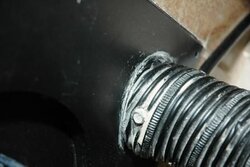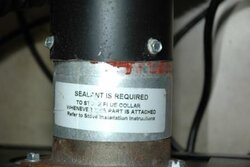Our Harmarn XXV was installed in February 2011. It was installed by the company that we bought it from. They did install an OAK. They seemed to do a good job and I believe that they followed the requirements in the manual for clearances, lengths, etc. We used it for several weeks and then I did what you all would probably consider a basic clean out -- I vacuumed it out as best I could and removed the few remaining pellets. I didn't remove any panels (although I think I loosened the burn pot a bit) or do the leaf blower thing as I hired the place I bought it from to do a Spring cleaning.
I am not too thrilled with the job they did. At the time, the only thing that bothered me was that my wife asked the guy to check the stove as the last time we used it, it didn't want to turn off. It just kept feeding pellets. Some pellets are briefly fed into the burn pot just after it is turned off, but this time they fed for a while and the fan speed did not decrease. Anyway, the guy first vacuumed out the stove, did a basic check and then decided to put some pellets in it. He ran some pellets through it and said it seemed to be working fine. He said we shouldn't worry much as the warranty "should be at least a couple years". Anyway, when I got home that night I vacuumed the stove out and removed the remaining pellets (again...).
Back to my stove concerns...
First off, when lighting the stove, particulary if there aren't any pellets already in the burn pot, I have smelled smoke. The smoke is only noticeable as the ignitor is doing its thing. Once the flame starts going, I don't smell any smoke. I didn't think much of it last year, but have been reading this site more often and see that people are saying I should never smell smoke.
Last night, I started up the pellet stove for the first time this Fall. It ran a bunch of pellets into the burn pot and then I noticed the ignitor start to work. A lot of smoke built up in the stove before the flames really started. During that time, I could smell a bit of smoke. My wife was probably 8 or 10 feet away and couldn't smell it. I was sniffing around the stove like some sort of a crazed person, trying to find where it was coming from. The smell seemed stronger toward the front of the stove, not the back where the pipes go in and out. Once the stove got going, the smoke smell dissipated. Tonight, I will check out the door gasket to see if that is where is could be coming from.
Should I not be smelling any smoke - even when starting the stove without any pellets in the burn pot?
Also, I noticed a fair amount of rust inside the stove. Unfortunately, I didn't notice it until after I started up the stove and it was feeding the pellets into the burn pot. I was surprised to see the rust, as I had checked the stove a couple times over the summer and didn't notice it previously. It had to have occurred over the past month or so. There was a definite metalic/rust like smell coming from the stove (from where the heat comes out). This smell took a whle to go away, but seemed to have stopped after about two hours.
Should I be doing anything now about the rust? I'll check the stove when I get home tonight, as it will be cooled off. However, I am not really sure what to look for.
Also, should I do anything different in the spring (other than doing the spring cleaning myself)? I am guessing that the moisture came in through either the exhaust vent or the OAK. Do you guys typically cover or seal them?
Also, is it normal for the OAK vent to wiggle where it connects to the stove? I have a fair amount of movement there.
Here are a couple pictures of the back of my stove, to the extent that helps with my questions.


Sorry for the long post and thanks for any help!
I am not too thrilled with the job they did. At the time, the only thing that bothered me was that my wife asked the guy to check the stove as the last time we used it, it didn't want to turn off. It just kept feeding pellets. Some pellets are briefly fed into the burn pot just after it is turned off, but this time they fed for a while and the fan speed did not decrease. Anyway, the guy first vacuumed out the stove, did a basic check and then decided to put some pellets in it. He ran some pellets through it and said it seemed to be working fine. He said we shouldn't worry much as the warranty "should be at least a couple years". Anyway, when I got home that night I vacuumed the stove out and removed the remaining pellets (again...).
Back to my stove concerns...
First off, when lighting the stove, particulary if there aren't any pellets already in the burn pot, I have smelled smoke. The smoke is only noticeable as the ignitor is doing its thing. Once the flame starts going, I don't smell any smoke. I didn't think much of it last year, but have been reading this site more often and see that people are saying I should never smell smoke.
Last night, I started up the pellet stove for the first time this Fall. It ran a bunch of pellets into the burn pot and then I noticed the ignitor start to work. A lot of smoke built up in the stove before the flames really started. During that time, I could smell a bit of smoke. My wife was probably 8 or 10 feet away and couldn't smell it. I was sniffing around the stove like some sort of a crazed person, trying to find where it was coming from. The smell seemed stronger toward the front of the stove, not the back where the pipes go in and out. Once the stove got going, the smoke smell dissipated. Tonight, I will check out the door gasket to see if that is where is could be coming from.
Should I not be smelling any smoke - even when starting the stove without any pellets in the burn pot?
Also, I noticed a fair amount of rust inside the stove. Unfortunately, I didn't notice it until after I started up the stove and it was feeding the pellets into the burn pot. I was surprised to see the rust, as I had checked the stove a couple times over the summer and didn't notice it previously. It had to have occurred over the past month or so. There was a definite metalic/rust like smell coming from the stove (from where the heat comes out). This smell took a whle to go away, but seemed to have stopped after about two hours.
Should I be doing anything now about the rust? I'll check the stove when I get home tonight, as it will be cooled off. However, I am not really sure what to look for.
Also, should I do anything different in the spring (other than doing the spring cleaning myself)? I am guessing that the moisture came in through either the exhaust vent or the OAK. Do you guys typically cover or seal them?
Also, is it normal for the OAK vent to wiggle where it connects to the stove? I have a fair amount of movement there.
Here are a couple pictures of the back of my stove, to the extent that helps with my questions.
Sorry for the long post and thanks for any help!



